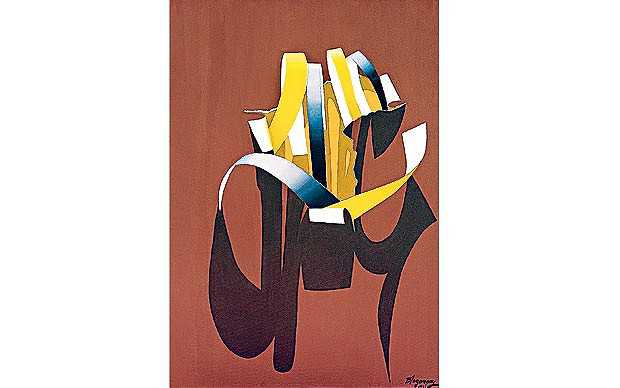By Colin Gleadell 10:59AM GMT 30 Nov 2010
 At Contemporary Istanbul, Istanbul’s contemporary art fair, which closed on Sunday, one of the star attractions was a tall 1962 abstract painting by Mubin Orhon. An artist who trained in Paris in the Fifties and died in 1981, he is one of the half dozen most sought after modern Turkish painters. The piece was not for sale, but was there for promotional purposes: it had been sold at a local auction house, Antik AS, earlier in the month for a record $965,000 (£618,400).
At Contemporary Istanbul, Istanbul’s contemporary art fair, which closed on Sunday, one of the star attractions was a tall 1962 abstract painting by Mubin Orhon. An artist who trained in Paris in the Fifties and died in 1981, he is one of the half dozen most sought after modern Turkish painters. The piece was not for sale, but was there for promotional purposes: it had been sold at a local auction house, Antik AS, earlier in the month for a record $965,000 (£618,400).
Art fairs in the West don’t normally promote auction highlights, but in Turkey, it seems, auctions and galleries are united in promoting Turkish art. Orhon’s painting, which had been bought by the Turkish billionaire food manufacturer Murat Ulker, was there as a symbol of the country’s emergence as a force in the international art market.
It was perhaps no accident that, as the art fair opened, two of the world’s biggest auctioneers made announcements about their activities in the Turkish market. Sotheby’s is to hold its third contemporary Turkish art sale in London next April, to be headed by Elif Bayoglu, who has been promoted from within the company after the suicide, reported in May, of Ali Can Ertug, the young expert who had led the company’s drive into the Turkish market.
Ertug had been a huge success. At his first sale, in March 2009 while the world was in deep recession, he met his target with a £1.4 million sale. Omer Koc, a member of one of Turkey’s richest families who credits Ertug with inspiring him to collect contemporary Turkish art, bought eight lots, including a hyper-real self-portrait as a bloody-nosed boxer by the rising artist Taner Ceylan, for £71,000. At Sotheby’s second Turkish auction, this April, Ertug raised the bar with a £2.4 million sale, and looked set to continue the upward trajectory next year. The Sotheby’s announcement was made to reassure all and sundry at Contemporary Istanbul, where Bayoglu was trawling for business, that the sale was in safe hands.
Within hours of the Sotheby’s statement, a new player was launched on to the scene when Bonhams announced that it was opening an office in Istanbul and would hold its first modern and contemporary Turkish art sale in London during the same week as Sotheby’s. The office is to be run by Erdem Sontur, a graduate of Istanbul University with a degree in art history and archaeology, with back-up from London. Bonham’s will be aiming, at least, to eclipse Christie’s, which for the past two years has included modern and contemporary Turkish art in its twice-yearly sales in Dubai, which account for an average half a million dollars at each sale.
But the target for all three Western auction houses is to rival Antik AS in Istanbul. Founded in 1981, Antik AS holds about six auctions a year and had a turnover last year of $45 million, of which $25 million was for modern and contemporary Turkish art. This month it launched its new season with a $10 million sale in this niche market.
In the past few seasons, Antik AS has been setting the pace at the high end, fetching record prices for the top group of Turkish moderns, mostly artists born in the early 20th century who studied in Paris in the post-war era and are no longer alive. These would include Mubin Orhon, Fahrelnissa Zeid, Turkey’s leading female artist (who reached $910,000 – though Sotheby’s improved on that price in April), and Erol Akyavas (whose massive The Siege holds the record for modern Turkish painting at $1.75 million). Last September it sold Symphony in Blue, a swirling abstract painting by Buhran Doganacy (born 1929), for $1.85 million to Marat Ulker, making Doganacy the most expensive living Turkish artist. In 1995, the painting had sold for $50,000, which gives some idea of the price increases that have been taking place. This month, Antik AS sold another work by Doganacy, Blossom, for $277,500.
Olgac Artram, the CEO of the family-owned auction house, says that the rises are due to demand outstripping supply for great works by these artists. This demand comes primarily from Turkish collectors, private museums and investment funds. In a new development, Yapik Kredi Bank and Akbank are bringing in new buyers by providing loans for art purchases. Far from seeing Sotheby’s, Christie’s and Bonhams as rivals jumping on his bandwagon, he welcomes their initiatives. He will even advise his clients on buying and selling through them. Ultimately, he believes, these initiatives will globalise the market, helping Turkish artists to gain their rightful place on the world stage.
via Art Sales: Turkey is looking hot this winter – Telegraph.

Leave a Reply